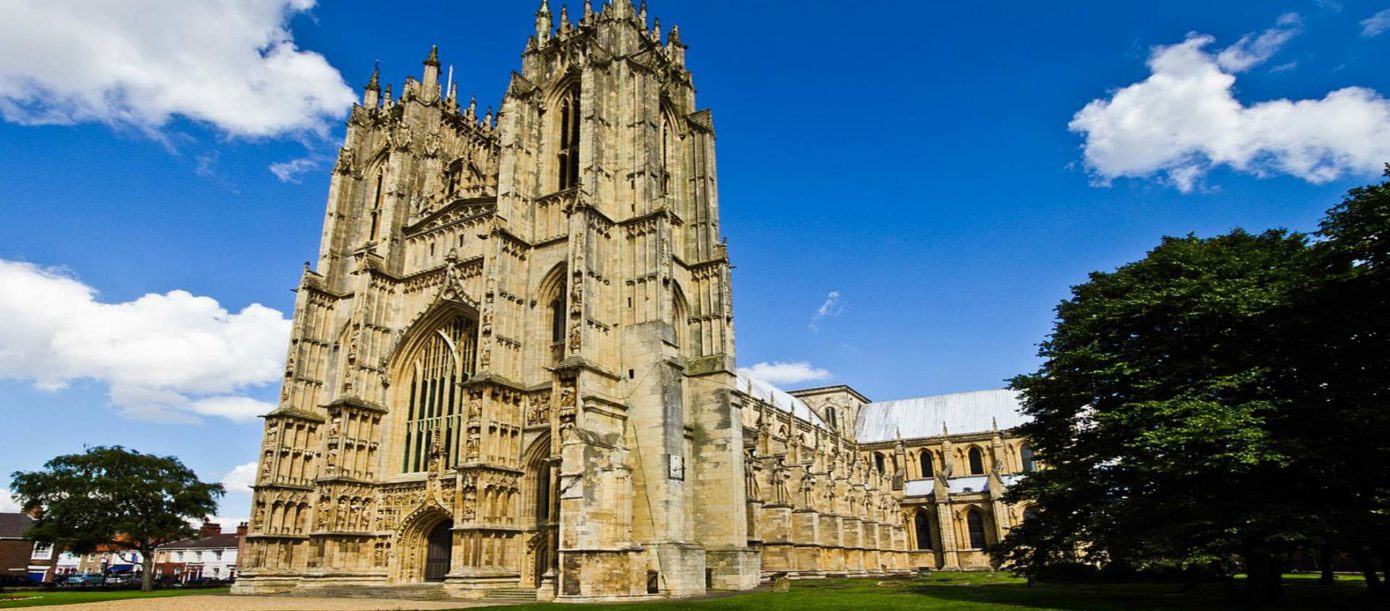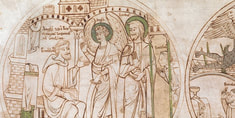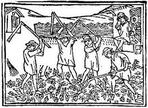|
This particular blog began as an idea of mine to write a bucket list of Anglo-Saxon monuments and sites that I’d still love to visit. Since many of my ideas mutate through distraction or curiosity, here we are with a totally different blog. Have you noticed how many place names in England contain the word minster? Westminster might be the most famous, but I’ve counted at least thirty and each has its own fascination. First, let’s see what minster means. It’s an ecclesiastic word, dating from Anglo-Saxon times. The word derives from the Old English "mynster", meaning "monastery", "nunnery", "mother church" or "cathedral", itself derived from the Latin "monasterium" and the Ancient Greek "μοναστήριον", meaning a group of clergy where the Brothers would cloister themselves to meditate. Let’s take York Minster as an example to distinguish between Minster and cathedral: it is officially the 'Cathedral and Metropolitical Church of St Peter in York'. Although it is by definition a cathedral, as it is the site of a bishop's throne, the word 'cathedral' did not come into use until the Norman Conquest. The word minster was what Anglo-Saxons named their important churches. Now let’s look at some of the other minsters: Please click the read more button  Axminster was recorded in the late 9th century as Ascanmynster. The name means "monastery or large church by the River Axe" and is a mixture of languages; the river name Axe has Celtic origins and mynster is an Old English word. (to the left Leominster Abbey) Beaminster (/ˈbɛmɪnstər/ BEM-in-stər) is a town and civil parish in Dorset, approximately 15 miles (24 km) northwest of the county town Dorchester. Beaminster is the product of the Anglo-Saxon age, dating back to around the 7th century, when it was known as Bebingmynster, meaning the church of Bebbe although the date of origin of the town is unknown. The place name and historic evidence indicates that it was probably the site of a primary Saxon minster church and was at the centre of a large episcopal estate. Bedminster was once a small town in Somerset. The town's origins seem to be Roman, centred on the present East Street and West Street. Finds here have been interpreted as an enclosed rural farmstead, dating between the 2nd and 4th centuries, The river Malago, which runs through Bedminster to join the Avon, was an early Christian place for baptism— the old word for which, beydd may be the origin of Bedminster's name By the late Anglo-Saxon period Bedminster was a manor held by King Edward the Confessor in the 11th century, Charminster is a village and civil parish in west Dorset, situated on the river 1 mile north of the county town Dorchester. The village name derives from the River Cerne and the small ‘minster’ church of St Mary, resulting in Cerneminster Durham Minster (See my novel The Master of the Chevron!) The predecessors of the bishops of Durham were the bishops of Lindisfarne who transferred their diocese to Chester-le-Street in 883AD. A Saxon minster was built and a succession of nine bishops reigned there until moving to Durham in 995AD. A wooden minster was built at Durham in 995AD and rebuilt in stone in 999AD. It stood for 94 years until 1093 when it was replaced by the Norman cathedral. Exminster is a village situated on the southern edge of the City of Exeter on the western side of the Exeter ship canal andriver Exe in the county of Devon. It is around 3.7miles south of the city centre. Exminster is an ancient village associated with a Saxon minster or religious community, founded in the 8th century. and left by King Alfred the Great to his youngest son, Aethelweard in his will of 889. Howden Minster Today can be seen the elaborately decorated ruins of a 14th-century chancel and chapter house, attached to the still operational cathedral-like minster church. Ilminster is town and civil parish in the South Somerset district. Ilminster is mentioned in documents dating from 725 and in a Charter granted to Muchelney Abbey(10 miles to the north) by Aethelred the Unready in 995. Kidderminster is a large market and historic minster town and civil parish in Worcestershire 17 miles south-west ofBirmingham and 15 miles north of Worcester. The land around Kidderminster may have been first populated by the Husmerae, an Anglo-Saxon tribe first mentioned in the Ismere Diploma, a document in which Aethelbald of Mercia granted a "parcel of land of ten hides" to Cyneberht. This developed as the settlement of Stour-in-Usmere, which was later the subject of a territorial dispute settled by Offa of Mercia in 781, when he restored certain rights to bishop Heathored. This allowed for the founding of a monastery or minstre in the area, the name appears as Chideminstre, meaning 'Cydda or Cydela's minster or monastery. Leominster, pronounced Lemster, is a market town in Herefordshire, England, at the confluence of the river Lugg and its and its tributary the river Kenwater. The town is 12 miles north of Hereford and seven south of Ludlow in Shropshire. The town takes its name from the English word minster meaning a community of clergy and the original Celtic name for the district Leon orLene, to flow. The Welsh name for Leominster is Llanllieni, with Llan suggesting a possible Celtic origin to the town's religious community. During the early Middle Ages, Leominster was home to Æthelmod of Leominster, an English saint. He is reputedly buried in Leominster. During the 8th and 9th Century, Danes (or Vikings) frequently raided the area. In 2015, two individuals (operating without landowner permission), using metal detectors, found a large hoard near Leominster (the Leominster hoard) consisting primarily of Saxon jewellery and silver ingots but also coins; the latter date to around AD 879. According to a news report, "experts believe it was buried by a Viking during a series of raids", Mercia was ruled by Ceowulf II Minster Lovell is a village and civil parish on the river Windrush about21⁄2 miles west of Witney in Oxfordshire. Minster Lovell village has three parts: Old Minster, Little Minster and New Minster. Old Minster includes the parish church,Minster Lovell Hall, the Old Swan Inn and Minster Mill Hotel. A large part of New Minster is the Charterville Allotments, which were founded by the Chartists in 1846–50. Minster Sheppey, Kent (See my trilogy, The Sceapig Chronicles!) Minster is a town on the north coast of the Isle of Sheppey in the Minster-on-Sea.The name of the town derives from the monastery founded in the area. There is some variation in the use of the name, with the local parish council being named Minster-on-Sea, while other sources, such as the local primary school, use Minster-in-Sheppey, in order to distinguish it from Minster in Thanet, also in the county of Kent. In around AD 670 King Ecgberht of Kent gave land at Minster for his mother Seaxburh of Ely to establish a Benedictine nunnery which was burnt down by theDanes in 855. Minster, also known as Minster-in-Thanet, is a village and civil parish in the Thanet District of Kent. It is the site of the Minster in Thanet Priory. The village is west of Ramsgate and to the north east of Canterbury. In 597 Augustine of Canterbury is said, by the Venerable Bede, to have landed with 40 men at nearby Ebbsfleet in the parish of Minster-in-Thanet, before founding a monastery in Canterbury; a cross marks the spot of his landing. Minster itself originally started as a monastic settlement in 670 AD. The buildings are still used as nunneries today. The first abbey in the village was founded by St Domneva a widowed noblewoman, whose daughter St Mildred, is taken as the first abbess. (Again, see my Sceapig Chronicles!) The tradition is that Domneva was granted as much land as a hind could run over in a day, the hind remains the village emblem. Sunderland Minster is a significant part of Sunderland’s heritage, dating as some suggest from as far back as 940AD. Rebuilt in the 20th century and following the grant of city status to Sunderland in 1992 the church was re-designated as ‘Sunderland Minster’ in 1998.history York Minster’s history began in 627AD when King Edwin of Northumbria was baptised in a simple wooden church at York within the site of the old Roman fort. The church was approved by the Pope and its dedication to St Peter reflected its links with Rome. The wooden church was rebuilt in stone and completed by King Oswald but the bishop’s seat was transferred for a time toLindisfarne. The minster was rebuilt again in 664AD and again after a fire in 741AD. It was eventually destroyed during the Norman siege of the city in 1069. I have deliberately not included all the minsters on my list. I didn't want the blog to become unmanageably boring but the wonderful Beverley Minster, Southwell Minster, Warminster, Misterton Minster and Newminster (Northumberland), Stow Minster, (Lincolnshire), Southminster, Wolverhampton Minster, Yetminster and Wimborne Minster (see my novel The Purple Thread!) are all deserving of a mention. Subjectively speaking, the most beautiful of them all - Lincoln Cathedral/Minster! I'm prepared to bet that I've missed some minsters from my list, too!
 Get a free eBook!Join my newsletter & receive a free digital copy of Heaven in a Wildflower, book 1 of my St. Cuthbert Trilogy, as well as monthly news, insights, historical facts, & exclusive content delivered straight to your inbox! Thank you!You have successfully joined my mailing list!
1 Comment
3/16/2023 10:12:14 am
John offers a fascinating insight into minsters. The next time I refer to a -minster town, this information will make Wikipedia redundant for me!
Reply
Leave a Reply. |
To buy your copy of Rhodri's Furies click the link below:
https://www.amazon.co.uk/Rhodris-Furies-Ninth-century-Resistance-incursions-ebook/dp/B0BPX9C2D3/ |





